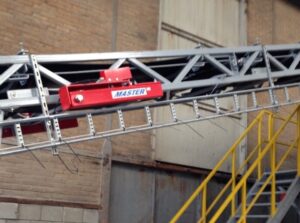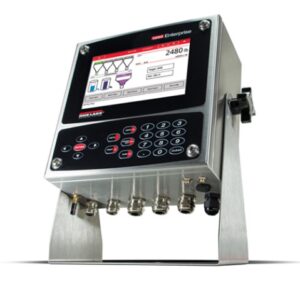“Measuring is knowing” is an old, well-known slogan and is certainly applicable in all sectors where bulk products are processed or transshipped.
There are various ways to measure the flow of a bulk flow. Sometimes the choice is simple, but often several alternatives are possible, and the user lacks the knowledge to make the right choice of measuring instrument.
In addition, there are also preconditions that can influence the choice, such as desired accuracy, verifiability, hygiene, ATEX, keeping clean and degree of maintenance.
Below is an overview of four possibilities to determine the amount of bulk goods in kilogram per hour or tonne per hour.
Belt weighers/belt scales
With a belt weigher, the amount of product on the conveyor belt is weighed (kg/m) by means of a weighing frame with load cell. In addition, the belt speed (m/s) is also measured.
These two variables are continuously multiplied in the weighing processor to kg/s or kg/hour. The time factor is known, so the weighing processor can easily generate a total count.
If conveyor belts are already used, the choice for a belt weigher is obvious and it is a matter of choosing the right model and seeing how the belt weigher can be built in. Important variables with regard to the choice are capacity, belt speed, bandwidth, a possible lifting angle of the conveyor belt and desired accuracy.
Moreover, the construction of the conveyor belt itself can also be decisive.
Accuracy of belt weighers can be from +/-0.25 per cent, but in that case everything must be optimised. Common for process belt weighers is +/-1 per cent.
There are also verifiable tyre weighers on the market. The weight and measure directive has three classes, namely class 0.5, 1 and 2.
In the Netherlands, if there are products with added value, calibration may only be carried out within class 0.5. With the so-called first approval, an accuracy of less than +/- 0.25 per cent must be achieved.
The regular maintenance of a tyre weigher consists of keeping the tyre clean around the weigher, visual inspection of the mechanical condition, daily zeroing and regular checking of the maximum range.
A weighing belt is a short conveyor belt containing a special belt weighing frame. This conveyor belt is specially designed to make the weighing function properly and also to keep the belt short. In general, a length is chosen that is at least 2.5 times the bandwidth. And usually, due to the small length, only flat rollers are used.

Screw weighing
With a screw weighing system, a short screw is set up weighing. To do this, a set of special pivot points is placed in the heart of the inlet, and towards the outlet comes a construction with a load cell on which the screw is hung.
The (net) weight (kg/m) is determined by means of a transmission. Both at the inlet and at the outlet of the screw there is a flexible cuff, with which the screw is closed, and with which the screw is also completely free, so that a good weighting is achieved.
The screw speed (m/s) is determined by placing an encoder on the shaft of the screw. By using the same weighing processor as the one for the belt weighers, the capacity in kg/hour can also be calculated here.
In general, if a product can be transported properly by a screw, a screw weighing can be applied. The accuracy is then +/-2 per cent.
The diameter of the screw depends on the capacity in kg/hour and the bulk weight. The length of the screw depends on the diameter and on the desired layout, but cannot be chosen for too long, because otherwise the ratio of the weight of the screw itself to the net content will run too far out of one.
The big advantage of a screw weighing is a dustproof installation and less daily maintenance than with a belt weigher.
Bulkslide flowmeter
With a Bulkslide flowmeter, the flow rate is measured in the vertical plane. A bulk flow is guided vertically over a curved chute. The design is such that the speed of the product is always the same.
When the product runs over the slide there is a centrifugal (flying) force. This in turn gives a reaction force that is measured in the load cell. This force is directly proportional to the capacity and is accurately calculated in the weighing processor up to kg/hour or tonne/hour.
A condition for proper operation is that the product runs smoothly and is not sticky.
If that is the case, an accuracy of +/-0.5-1 per cent can be achieved.
There are versions available in steel lacquered or stainless steel. The chute is either made of stainless steel or Hardox if there are abrasive products. In case of great wear, it is also possible to cover the sliding plate with ceramic. A HT version is available, where products up to 160° Celsius can be measured.
The device is also dustproof and requires very little maintenance.

Bulk weighers
A Bulk weigher basically consists of a weighing hopper with valve and above that a buffer hopper with valve.
If necessary, a drain hopper can also be placed under the weighing hopper, ensuring that the weighing hopper can always store its product. A continuous flow of product is weighed batch-wise, so that a high accuracy can be achieved.
At the start, the valve of the buffer hopper is open and that of the weighing hopper is closed. The product now runs directly into the weighing hopper. When the weighing hopper is full (setting value), the valve of the buffer hopper closes. The weighing processor now determines the weight of the product and stores it.
The lid of the weighing hopper opens and the weighing hopper is emptied. The valve closes again and a zeroing takes place. The supply of product has continued as usual and has accumulated in the buffer hopper. The valve of the buffer hopper now opens and the product that is in the buffer hopper falls into the weighing hopper.
The valve of the buffer hopper remains open until the weighing hopper has filled up again to the setting value. Then the valve of the buffer hopper closes again and the cycle repeats.
The main advantage is high accuracy. However, the disadvantage is a large degree of necessary maintenance because there are quite a few moving parts in the system.
The dimensions of the hoppers are determined by the capacity and the bulk weight. This means the higher the volume capacity (m3/hour) the larger the hoppers and the more height is needed. This can be a breaking point for not choosing a Bulk Weigher.
Here too, the product must be (reasonably) running well and not sticking.
In April 2023, Ramsey Systems were discontinued by Thermo Fisher Scientific. Minprovise International, a leading provider of mining equipment and contractor services have secured a new channel partnership with Rice Lake Weighing Systems-Master, a global manufacturer of weighing-related products for measurement and automated process control, enabling them to continue to supply customers with quality precision products in the belt weighing market.



